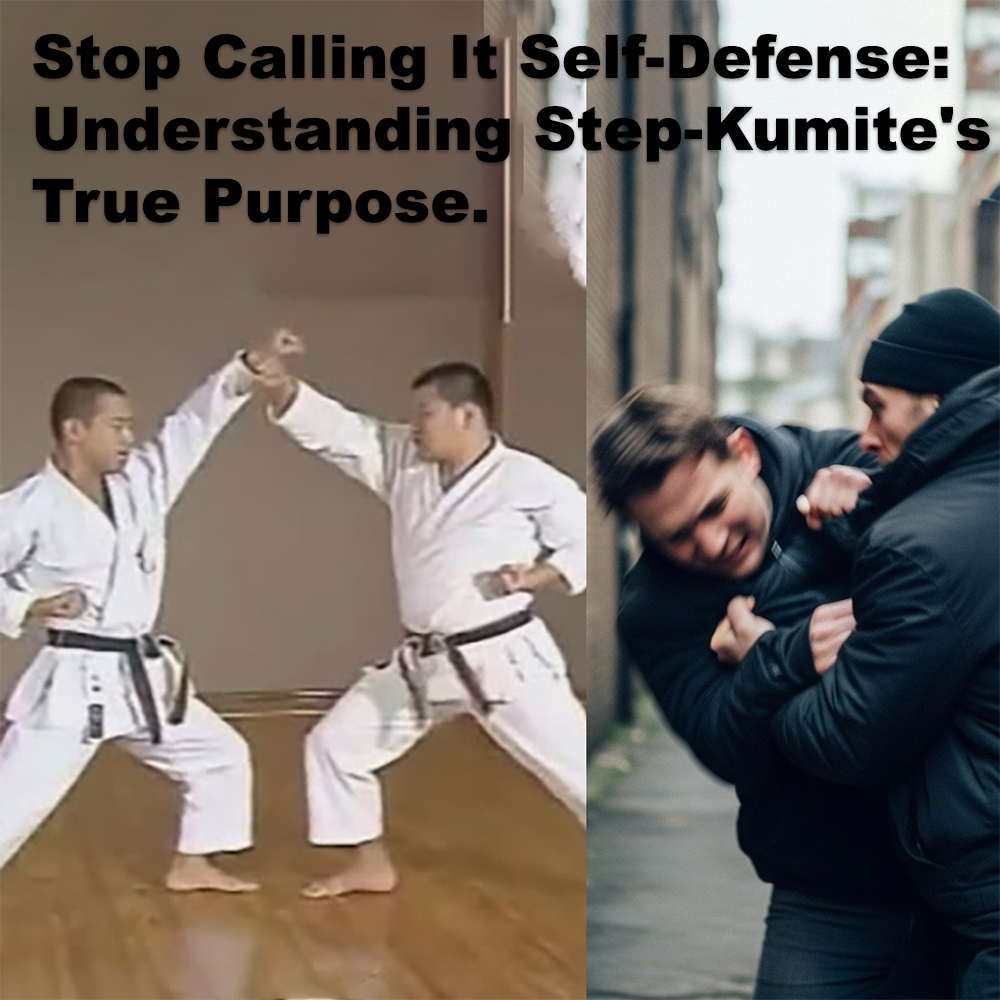
(Approx 3 minute 20 second read)
Some people will defend their style and their methods of practice until the very end. It doesn’t matter what evidence you provide showing that it might not serve the purpose it’s advertised for.
.
My recent articles on step-kumite proved this point. One individual posted a link to his own site in an attempt to disprove my article.
.
We all have different opinions – but what matters above all else is context.
.
In martial arts, context refers to the circumstances in which a technique or method is used. It’s about understanding the why, when, and how – not just the movement itself. Context means asking what a method is supposed to prepare you for, and whether it actually does.
.
I repeat this word often – context – but some people still don’t understand what it means. Or perhaps they just choose to ignore it.
.
If you believe that step-kumite works for you – fine. That’s your choice. But please acknowledge that what you’re practicing is not real in any meaningful sense of the word. It is not self-defense, plain and simple.
.
The Shotokan practitioner who posted the link cited the same points I’ve heard many times before.
.
The first was ma-ai – timing and distance. The second was that it helps beginners get used to the idea of someone coming at them with a punch. There were other points, but these were the main ones he led with.
.
Let’s start with timing and distance. He claimed it helps with self-defense. Immediately, alarm bells go off. This is the wrong timing and distance for self-defense. No one launches an attack from six feet away with a long step-in punch for you to step back and block.
.
That’s not how violence happens.
.
Now to the second point: “It helps beginners understand what it’s like to have a punch come toward them.” In what world does that happen the way it does in step-kumite?
.
Practitioners stop their punches before contact – there’s no penetration. The attacker lunges and stops at full extension, pausing short of the target.
.
How does that prepare anyone to deal with being punched? It doesn’t. The timing, distance, and type of attack doesn’t match real-world violence.
Some say step-kumite is just for beginners. But I’ll never understand that mindset.
.
If we know real violence is sudden, close, and chaotic – why not start beginners with that reality in mind? This is what I do in my dojo. Why waste time teaching methods that have no relation to what we’re ultimately preparing them for?
.
Yes, beginners need structure and safety. But structure doesn’t mean fantasy. You can design safe, progressive drills that reflect real-world attacks: close-range grabs, surprise strikes, forward pressure – without choreographing unrealistic, six-foot lunges.
.
Step-drills are good for one thing only: doing step-drills. They don’t prepare anyone – beginner or advanced – for actual self-defense. So if your goal is to teach people how to protect themselves, start from that premise. Don’t detour into something that was never meant for it.
.
Self-defense happens much closer.
.
It’s messy, chaotic, and unpredictable. There’s no warning, no formal stance, and no choreographed attack. That’s the reality we should be preparing for.
.
I’m not here to tell anyone what to practice. If you enjoy step-kumite, that’s fine – as long as you’re honest about what it is and what it isn’t.
.
It’s not self-defense training. It’s a traditional exercise with roots in karate’s evolution.
.
When karate was brought from Okinawa to mainland Japan, it was reshaped to align with existing Japanese martial arts like kendo and judo. Formal attacks, clear roles of attacker and defender, and long linear movements were introduced – largely through the influence of Gigo Funakoshi, who trained in both karate and kendo. This shift helped karate fit into the university and budo culture of the time, but it also moved it further from practical self-defense.
.
Context matters.
.
Step-kumite is not – and never was – about preparing for real-world violence. It was created as a controlled exercise – and this is important – between two karateka, following an agreed-upon format, using basic, exaggerated methods. It has nothing to do with the unpredictable, up-close, and chaotic nature of real self-defense.
.
You can practice it within the framework of tradition. That’s fine. Just call it what it is – and stop calling it self-protection.
.
If you want to teach real-world defense, you have to train with what works in that context. Because ultimately, lives aren’t protected by choreography – they’re protected by understanding.
.
The truth is simple: your student won’t be attacked by a karateka lunging in from six feet away. They’ll be grabbed, sucker-punched, ambushed, or overwhelmed – by someone who doesn’t care about tradition or aesthetics.
.
If you claim it’s self-defense, then it has to work under the conditions of real violence. If it doesn’t, then stop calling it that. Simple.
.
.
Written by Adam Carter
